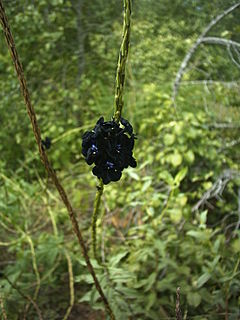Zygia steyermarkii is a species of legume in the family Fabaceae. It can only be found in Ecuador.

The violet-headed hummingbird is a species of hummingbird in the family Trochilidae. It is the only species in the genus Klais.
Podocarpus steyermarkii is a species of conifer in the family Podocarpaceae. It is found only in Venezuela.
Draba steyermarkii is a species of flowering plant in the family Brassicaceae. It is found only in Ecuador. Its natural habitats are subtropical or tropical moist montane forests and subtropical or tropical high-altitude grassland. It is threatened by habitat loss.
Calamagrostis steyermarkii is a species of grass in the family Poaceae. It is found only in Ecuador.
Centropogon steyermarkii is a species of plant in the family Campanulaceae. It is endemic to Ecuador. Its natural habitat is subtropical or tropical moist montane forests.
Fuchsia steyermarkii is a species of plant in the family Onagraceae. It is endemic to Ecuador.
Ilex steyermarkii is a species of plant in the family Aquifoliaceae. It is endemic to Venezuela.
Larnax steyermarkii is a species of plant in the family Solanaceae. It is endemic to Ecuador.

Stachytarpheta is a plant genus in the verbena family (Verbenaceae). The flowers are rich in nectar and popular with many butterflies, such as the South Asian crimson rose, Malabar banded swallowtail, and grass yellow Hummingbirds, especially small species like Lophornis coquettes, Chlorostilbon emeralds, and Discosura thorntails, are especially attracted for nectar. Several species in this genus are known as porterweeds.
Stachytarpheta svensonii is a species of plant in the family Verbenaceae. It is endemic to Ecuador. Its natural habitat is subtropical or tropical dry forests.
Jasarum is a monotypic genus of flowering plants in the family Araceae. The single species that makes up the genus is Jasarum steyermarkii. It was discovered in 1960, but wasn't described until 1977 due to classification difficulties with regards to understanding this species. Jasarum is now believed to be closely related to Caladium and it may have evolved from Caladiums that once grew in seasonal swamps. Jasarum steyermarkii is an aquatic species that is native to two river systems in Venezuela and Guyana. It is found growing in acidic blackwater and is unique in that it is the only submerged aquatic species in Araceae endemic to South America. Jasarum steyermarkii has thin ribbon-like leaves that can get as long as 30 cm. Running down the length of the leaf is a clear midrib that has veins moving at right angles to the edge of the leaf. The spathes produced open above the surface of the water and are about 15 cm long.

Stachytarpheta jamaicensis is a species of plant in the family Verbenaceae, native throughout the Caribbean. It has many common names including blue porterweed, blue snake weed, bastard vervain, Brazilian tea, Jamaica vervain, and light-blue snakeweed. It is unclear whether S. indica is a separate species. It is usually found along country roadsides and it grows also well as a ruderal plant on disturbed terrain. It is an invasive species in some places.

Strymon bazochii, the lantana scrub-hairstreak or smaller lantana butterfly, is a butterfly in the family Lycaenidae. It is found from Paraguay north through Central America, the West Indies and Mexico to southern Texas. It was introduced to Hawaii in 1902 to control Lantana species, in which it has proven unsuccessful.

Stachytarpheta indica is a species of plant in the family Verbenaceae, native to the tropical Americas. It has often been included in the species S. jamaicensis.

Trimezia martinicensis is a species of bulbous plant in the family Iridaceae. Originally from South America and the West Indies, it is now widely naturalized throughout the tropics. Common names include Martinique trimezia, yellow walking iris and forenoon yellow flag.

Stachytarpheta mutabilis is a species of flowering plant in the verbena family known by the common names changeable velvetberry, coral porterweed, pink snakeweed, red snakeweed, and pink rat tail. It is native to Mexico, the Caribbean, and South America. It can be found in many other places as an introduced species. It is cultivated as an ornamental plant.

Stachytarpheta cayennensis is a species of flowering plant in the verbena family known by many English language common names, including blue snakeweed, Cayenne snakeweed, dark-blue snakeweed, bluetop, nettle-leaf porterweed, rattail, rough-leaf false vervain, blue rat's tail, Brazilian tea, Cayenne vervain, false verbena, joee, nettleleaf velvetberry, and Cayenne porterweed. Names in other languages include honagasō (Japanese), gervão-urticante, piche de gato, rabo de zorro (Spanish), herbe á chenille, herbe bleue, queue de rat (French), ōi or ōwī (Hawaiian), sakura or ouchung (Chuukese), and tiāki (Māori). It is native to the Americas, from Mexico south through Central and South America to Argentina, as well as many islands of the Caribbean. It is known in many other parts of the world as an introduced species, including regions in Africa, India, Indonesia, Australia, Florida in the United States, and many Pacific Islands. Its distribution is now considered pantropical. In many places, such as New Caledonia, it has become an invasive species.

Stachytarpheta urticifolia, the nettleleaf velvetberry, is a species of flowering plant in the verbena family. In some countries it is considered as an invasive weed.
Hypericum steyermarkii is a species of flowering plant in the genus Hypericum, and is the only species in Hypericum sect. Santomasia. The species is found in the Chiapas province of Mexico as well as in Guatemala. The species was named for the collector of its holotype, Julian Steyermark, an American botanist.









